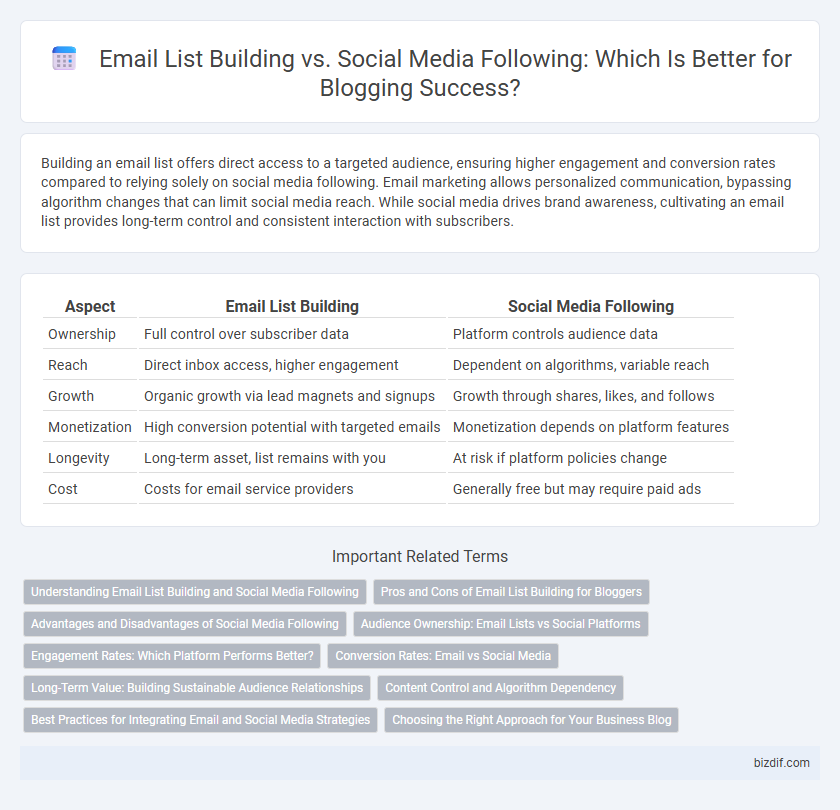Building an email list offers direct access to a targeted audience, ensuring higher engagement and conversion rates compared to relying solely on social media following. Email marketing allows personalized communication, bypassing algorithm changes that can limit social media reach. While social media drives brand awareness, cultivating an email list provides long-term control and consistent interaction with subscribers.
Table of Comparison
| Aspect | Email List Building | Social Media Following |
|---|---|---|
| Ownership | Full control over subscriber data | Platform controls audience data |
| Reach | Direct inbox access, higher engagement | Dependent on algorithms, variable reach |
| Growth | Organic growth via lead magnets and signups | Growth through shares, likes, and follows |
| Monetization | High conversion potential with targeted emails | Monetization depends on platform features |
| Longevity | Long-term asset, list remains with you | At risk if platform policies change |
| Cost | Costs for email service providers | Generally free but may require paid ads |
Understanding Email List Building and Social Media Following
Email list building involves collecting subscribers' email addresses to establish direct and personalized communication, which typically results in higher conversion rates and better audience retention. Social media following refers to the number of users who engage with a brand's content on platforms like Instagram, Facebook, or Twitter but offers less control over algorithms and user data. Prioritizing email lists enables bloggers to nurture loyal relationships and implement targeted marketing strategies, while social media following boosts brand visibility and real-time engagement.
Pros and Cons of Email List Building for Bloggers
Email list building offers bloggers direct, personalized access to their audience, ensuring higher engagement rates and better conversion potential compared to social media platforms. However, managing an email list requires consistent content creation, compliance with regulations like GDPR, and can involve costs for email marketing services. Unlike social media, email lists are owned by bloggers, reducing dependence on platform algorithm changes and enhancing long-term audience retention.
Advantages and Disadvantages of Social Media Following
Social media following offers real-time engagement and rapid audience growth by leveraging platforms like Instagram and Twitter, enabling bloggers to increase visibility and interact directly with users. However, dependence on platform algorithms can limit reach unpredictably, and followers may not convert into loyal customers or email subscribers, reducing long-term marketing effectiveness. Unlike email lists, social media audiences are less controllable, making it harder to maintain consistent communication and ownership over the communication channel.
Audience Ownership: Email Lists vs Social Platforms
Email lists provide direct access to your audience without intermediaries, ensuring greater control over communication and content delivery. Social media platforms impose algorithms and policies that can limit reach and engagement, reducing your ability to own and monetize your following fully. Building an email list cultivates a more reliable and sustainable connection with your audience, free from platform restrictions.
Engagement Rates: Which Platform Performs Better?
Email list building consistently achieves higher engagement rates compared to social media following, with average open rates around 20-30% and click-through rates of 2-5%, whereas social media engagement typically ranges between 1-3% depending on the platform. Email allows for personalized, direct communication, fostering deeper connections and increased user responsiveness. In contrast, social media engagement often suffers from algorithm changes and content saturation, limiting organic reach and interaction.
Conversion Rates: Email vs Social Media
Email list building consistently delivers higher conversion rates compared to social media following, with average email conversion rates around 6.05% versus social media's 1-2%. Targeted email campaigns enable personalized content and direct calls-to-action, fostering stronger engagement and customer loyalty. In contrast, social media's broader reach often results in lower immediate conversions despite higher overall exposure.
Long-Term Value: Building Sustainable Audience Relationships
Email list building fosters direct communication with subscribers, offering higher engagement rates and ownership of your audience compared to social media platforms. Social media following depends heavily on platform algorithms and policies, which can change and limit reach, reducing long-term reliability. Prioritizing email lists ensures sustainable audience relationships through personalized content and consistent access, driving lasting growth and monetization opportunities.
Content Control and Algorithm Dependency
Building an email list offers unparalleled content control, allowing bloggers to directly reach subscribers without interference from third-party algorithms. Social media followings are subject to platform-driven algorithms that dictate content visibility, often limiting organic reach and engagement. Relying on email lists reduces dependency on fluctuating social media policies, ensuring consistent audience access and stronger long-term relationship building.
Best Practices for Integrating Email and Social Media Strategies
Integrating email list building with social media following enhances audience engagement by leveraging targeted email campaigns alongside dynamic social content sharing. Best practices include cross-promoting sign-up incentives on social platforms and embedding social sharing buttons within newsletters to amplify reach. Consistent segmentation of email subscribers based on social media behavior enables personalized messaging, boosting conversion rates and fostering loyal community growth.
Choosing the Right Approach for Your Business Blog
Email list building offers a direct channel to engage your audience with personalized content and high conversion potential, making it ideal for nurturing long-term customer relationships in business blogs. Social media following drives immediate traffic and brand awareness through shareable content and real-time interaction but often lacks ownership and consistent visibility. Selecting the right approach depends on your business goals; prioritize email marketing for sustained audience engagement and leverage social media to amplify reach and attract new visitors.
Email list building vs social media following Infographic

 bizdif.com
bizdif.com